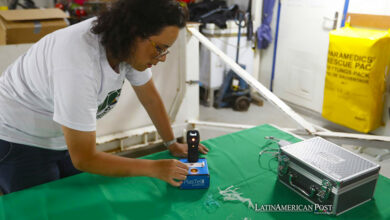Sexual Harassment in Universities: What To Do And What Is Still Missing?
Last week, the appointment and then declination of academic Víctor De Currea-Lugo to the Colombian embassy in the United Arab Emirates fueled the feminist debate on sexual harassment in universities .

Photo: Freepik
LatinAmerican Post | Staff
Escucha este artículo
Leer en español: Acoso en las universidades: ¿Qué hacer y qué falta aún?
Last week the appointment of Víctor De Currea-Lugo as Colombian ambassador to the United Arab Emirates was made public. After this, the representative to the chamber Jennifer Pedraza expressed her dissatisfaction with the appointment on Twitter when she trilled about the accusations of sexual harassment that fall on De Currea. After some media outlets investigated the accusations and reviewed the testimonies of the alleged victims, De Currea declined the appointment as ambassador.
Beyond the particular case of this appointment, this news reopened the debate on sexual harassment in universities. Some feminist voices draw attention to the problem behind the accusations: sexual harassment and intimidation of students by teachers is very common in universities, what to do?
How to identify sexual harassment in the academic space?
Unfortunately, the allegations against Victor De Currea are just one example among many cases of bullying in the academic space. Although this is a long-standing problem, it has not been until a few years ago that universities have taken measures in this regard. In the first place, the first thing that the institutions have had to do has been to know how to identify what constitutes a case of sexual harassment.
The Gender Affairs Observatory of the National University of Colombia defines sexual violence as "those exercised to force the victimized person to develop or tolerate a certain action of a sexual nature or to maintain sexualized, physical or verbal contact, against their will, through the use of force, coercion, psychological pressure, threat, intimidation, bribery, blackmail, manipulation or any other mechanism that annuls or limits personal will".
Cambio magazine gathered five testimonies from De Currea-Lugo's denouncers. The testimonies had behaviors in common such as comments about the physique of the students and manipulations to meet at home instead of in public places. These and other behaviors that call into question the full consent and conscience of the student should alert you and can be discussed with a college counselor.
Also read: What to do in Case of Experiencing Violence or Harassment at Work?
What to do if I identify that I may be a victim of sexual harassment at my university?
Due to the broad feminist debate that has taken place in recent years in academic spaces and what some have called "the Me Too era", many universities now have protocols and courses of action in case of sexual harassment. The Attention Route for gender-based violence and sexual violence of the National University of Colombia, for example, foresees what to do in cases of emergency and differentiates them from other cases that seek to prevent the harassment from continuing. These action routes serve to, on the one hand, help the complainant if she needs psychological or physical attention. The other side, of course, is the complaint itself.
The aforementioned route conceives two possible processes after the complaint: an alternative pedagogical procedure and a disciplinary process. The idea of this is that not only the accused is punished, but also that there are spaces for reflection and pedagogy in which gender issues and harassment are discussed in universities.
These protocols, although they aim at the same thing, may vary depending on the university. The MAAD protocol of the Universidad de Los Andes, for example, contemplates any type of "situation that threatens healthy coexistence among members of the community, puts the physical or psychological integrity of people at risk and constitutes some form of abuse, harassment, threat, discrimination, sexual or gender violence". With a broader and perhaps less punitive approach, this course of action is also intended to be an instrument of prevention.
So if you have identified a case of harassment at your university, the first thing you should do is find out about the specific mechanisms of the institution that you can use to report it. You can find them out at your university's welfare department. We know that not all institutions have protocols and action routes, so remember that if this is your case, you can always demand it or talk to a student advisor to find out what your options are.
What is there left to do?
Although, as we have said, in recent years universities have made an effort to identify and deal with this problem, there are still many questions and issues to be reviewed. The protocols cited in this article, for example, are no more than ten years old. Thus, the De Currea-Lugo complainants, whose testimonies range from 2013 to 2017, did not have access to these courses of action. What to do in the case of late complaints (very common in the case of sexual harassment due to the consequences it has on mental health) has also not been contemplated, which leaves some victims without instruments for complaint.
In her podcast "A fondo" the journalist María Jimena Duzán opened her microphones to the complainant and the accused. De Currea-Lugo does not deny many of the things he is accused of but rather argues that they do not constitute harassment. This reveals that many times it is the teachers who do not know how to identify sexual harassment—he himself has called it “flirting”—. Thus, it is evident that not only reporting routes are needed, but also pedagogy spaces in universities for professors and students, since all members of the community should be informed on gender and sex issues.
It is true that there is still a long way to go in terms of women's rights and equality between the sexes in the Academy. However, there are already protocols in some universities that protect the complainant as well as the presumption of innocence of the accused. In addition, universities have the potential to be pedagogical spaces from which there can be a high-level debate and from where sexual harassment behaviors can be prevented, rather than punished. We invite our readers to find out about the protocol in theirs (and to demand it if there is none) and to denounce it without fear. While gender issues continue to be discussed in the Academy, they must also be a concern in the practical life of students and professors in universities.




